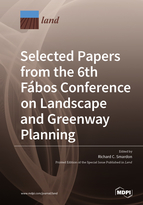Selected Papers from the 6th Fábos Conference on Landscape and Greenway Planning: Adapting to Expanding and Contracting Cities
A special issue of Land (ISSN 2073-445X).
Deadline for manuscript submissions: closed (1 June 2020) | Viewed by 38656
Special Issue Editor
Interests: visual resource management; landscape assessment; cultural ecosystem services; wetland assessment
Special Issues, Collections and Topics in MDPI journals
Special Issue Information
Dear Colleagues,
The Fábos Conference on Landscape and Greenway Planning is held every three years to bring together experts who are influencing landscape planning, policy making, and greenway planning from the local to the international level. It is intended to highlight recent trends and expand the literature about landscape and greenway planning. The aim is to explore how landscape architects and planners from different countries have approached greenway planning and to understand how greenways have been tailored to each county’s unique geographical, cultural, and political circumstances.
The theme for the 2019 conference (https://sites.google.com/umass.edu/fabosconference2019, 28–30 March 2019, University of Massachusetts Amherst, MA, USA) explores the social and ecological potential of linear green spaces in urban areas that are experiencing decline or those that are booming. We look to understand the variety of ways in which urban greenways are conceived, designed, built, used, and maintained in cities across the globe in response to economic and demographic trends. More specifically, the following topic areas are covered:
- Cultural and/or historical landscapes;
- Wildlife habitat;
- Human health and well-being;
- Recreation;
- Urban waterfronts;
- Expanding and contracting cities;
- Equity and access;
- Climate change and resilience;
- Implementation and governance.
The conference provides an opportunity to publish full papers in printed proceedings (https://sites.google.com/umass.edu/fabosconference2019/publications). This Special Issue welcomes selected papers from the conference proceedings. Submitted contributions will be subject to peer review and—upon acceptance—will be published with the aim of rapidly and widely disseminating research results, developments, and applications.
It should be noted that submitted manuscripts should fulfil the following requirements: (1) The paper should be expanded to the size of a research article (at least 50% additional, new, and unpublished material compared to the published proceedings papers); (2) the conference paper should be cited and noted on the first page of the paper; (3) authors are asked to disclose that it is a conference paper in their cover letter and include a statement on what has been changed compared to the original conference paper. Land does not publish pilot studies or studies with inadequate statistical power.
In addition, papers that will be published in this e-conference-related Special Issue will receive a 20% discount on the APCs (Article Processing Charges).
Looking forward to receiving your contributions.
Professor Emeritus Richard C. Smardon
Guest Editor
Manuscript Submission Information
Manuscripts should be submitted online at www.mdpi.com by registering and logging in to this website. Once you are registered, click here to go to the submission form. Manuscripts can be submitted until the deadline. All submissions that pass pre-check are peer-reviewed. Accepted papers will be published continuously in the journal (as soon as accepted) and will be listed together on the special issue website. Research articles, review articles as well as short communications are invited. For planned papers, a title and short abstract (about 100 words) can be sent to the Editorial Office for announcement on this website.
Submitted manuscripts should not have been published previously, nor be under consideration for publication elsewhere (except conference proceedings papers). All manuscripts are thoroughly refereed through a single-blind peer-review process. A guide for authors and other relevant information for submission of manuscripts is available on the Instructions for Authors page. Land is an international peer-reviewed open access monthly journal published by MDPI.
Please visit the Instructions for Authors page before submitting a manuscript. The Article Processing Charge (APC) for publication in this open access journal is 2600 CHF (Swiss Francs). Submitted papers should be well formatted and use good English. Authors may use MDPI's English editing service prior to publication or during author revisions.
Keywords
- Cultural and/or historical landscapes
- Wildlife habitat
- Human health and well-being
- Recreation
- Urban waterfronts
- Expanding and contracting cities
- Equity and access
- Climate change and resilience
- Implementation and governance






